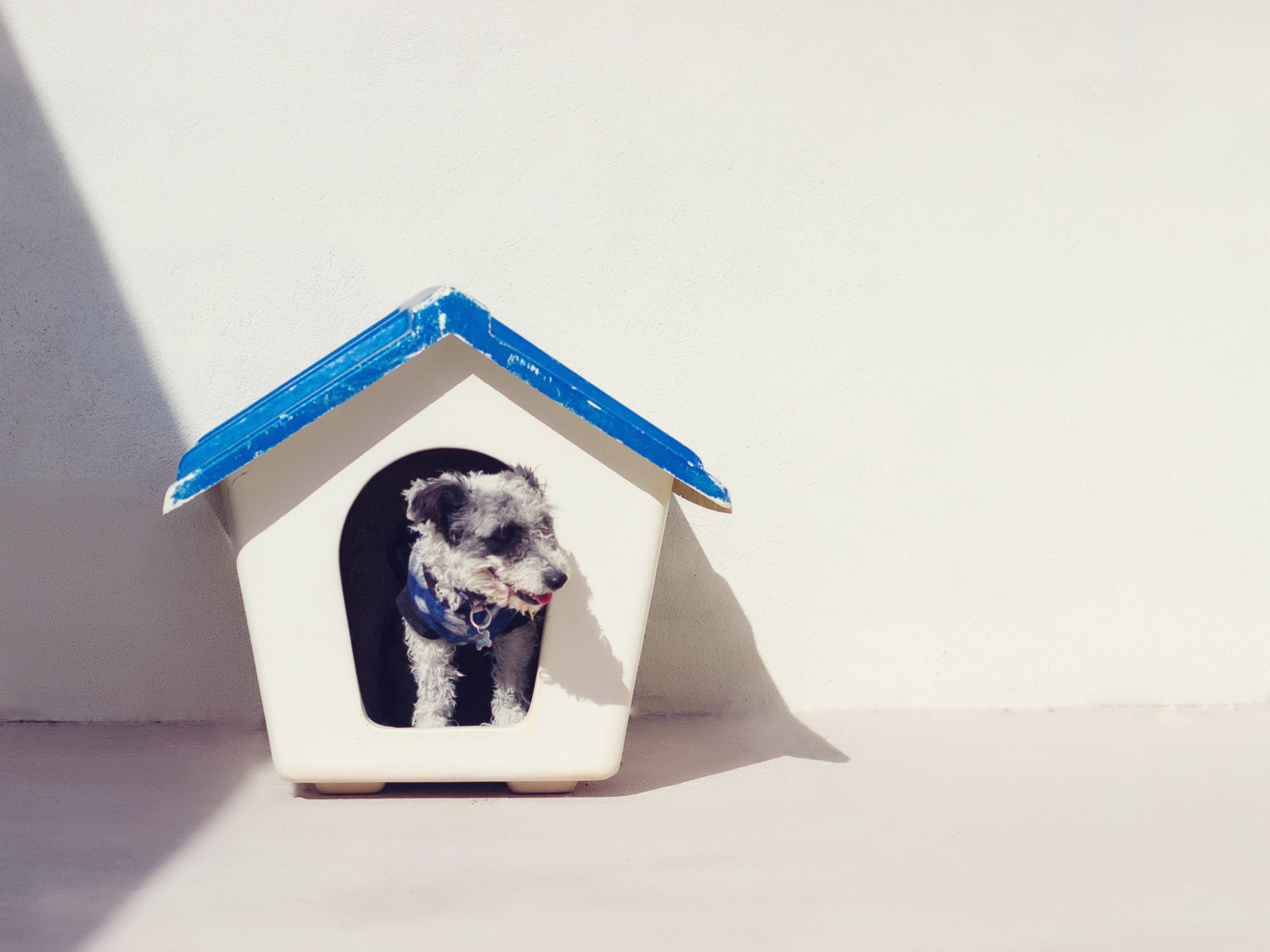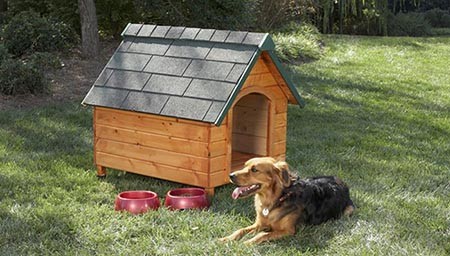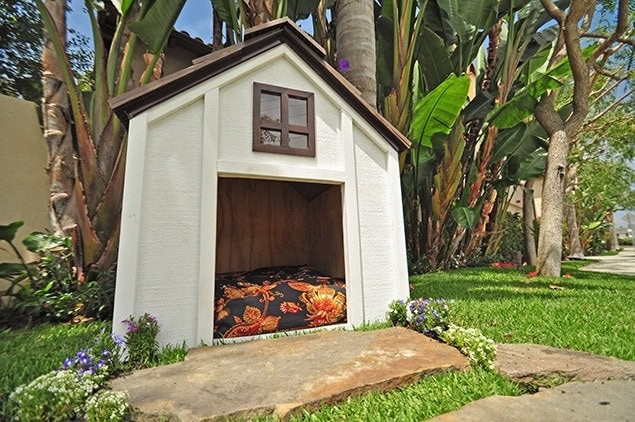If you’re not going to let your dog stay inside (or if you just need him to spend a lot of time in the backyard), you’re going to need to give him a dog house sooner or later. That raises a multitude of questions, not least of which is this: how big should a dog house be?
The general standard is that your dog should have enough room to stand up, turn around, and lie down, but not much more than that. The idea is to give them a snug, cozy refuge from the outside world, as this makes dogs feel safe and secure, whereas a giant mansion of a house will leave them feeling exposed.
Of course, that guideline doesn’t help much when you’re shopping for a dog house; then, you need real data. Below, we’ll show you exactly how to determine the right size dog house for your pooch.
Finding the Right Dog House Dimensions
At some point, you need to translate the golden rule we listed above into actual numbers so that you can buy (or build) a dog house that fits your pup.
The first step, of course, is to measure your dog. You need to know his length from the tip of his nose to his butt, and his height from paw to shoulder. This way, you can make sure his home fits him perfectly.
Next, you need to decide what kind of house you want to make. Most have slanted roofs, which allows rain to run off and gives your pup more room when he enters the house. This means you’ll need to know how tall the roof is in two places — at the highest and lowest points.
Once you know how big your dog is and what you want your house to look like, it’s easy to figure things out from there — and since the house will be custom-fit for your pup, you won’t have to worry about any variation between the dog house dimensions by breed.
Other Factors to Consider
You should absolutely take your local weather into consideration before deciding on dog house dimensions. If you live in an area where it gets incredibly cold in the winter, you might want to make the house a little more snug so that your dog’s body heat is better-preserved.
Likewise, if you live in a place with stifling summers, allowing your pooch a little more room will enable the air to circulate better and keep him cool.

Different Formulas You Can Use
There’s no one-size-fits-all formula for determining the size of your dog house. You can find a variety of ideas online, some of which we’ve reproduced below:
1. Asheville, NC Humane Society
For a house with a slanted roof, they believe that the dimensions should be as follows:
- Depth: dog’s length + 12”
- Width: dog’s length + 18”
- Height: dog’s height + 3” on the low side, dog’s height + 9” on the high side
2. Ontario Humane Society
The Ontario Humane Society goes into quite a bit of detail when it comes to house sizing (meaning, get ready to do some math).
They believe that, to determine how many square inches of floor space your dog needs, you multiply each inch of your dog’s height by 36. So, a 12” tall dog would need 432 square inches of floor space.
The height is a bit easier to determine — simply take your dog’s height when seated and add a couple inches.
3. WOOD Magazine, Issue #80 (Aug 1995)
Granted, the editors of this magazine are probably more well-versed in how to build the house than determining how much room Fido needs, but their recommendations are as follows:
Depth: 1.5X the length of your dog
Width: ⅔ the length of your dog
Height: 1.5X the height of your dog (measured in a seated position)
- You might find inspiration from one of these Dog Youtube Channels
4. Blythe Wood Works A-B-C Method
Blythe Wood Works is a manufacturer of cedar dog houses. To determine the size of their homes, they use a copyrighted formula they call the “A-B-C Method” (reproduced with their permission):
- The height of the door opening should be an inch taller than the dog’s standing height at his shoulder. They also recommend elevating the house by half of whatever “A” is.
- The width and depth of the house should be at least the distance from the dog’s nose to his butt, excluding his tail.
- The height of the house itself should be 1.25x the distance from the top of his head to his toes.
You can also visit their website for more help, as they have an online calculator to assist you with the measurements.

5. DogHouses.com
Given that selling dog houses is what these guys do, it makes sense that they’d have their own formula. Their guiding principle is that the house should be just big enough for your pup to enter and become settled, and the formula they use is:
- The height of the door should be at least ¾ of the dog’s shoulder-to-ground measurement. You can make it taller if you like, but remember that your dog will naturally lower his head to enter.
- The house should be no shorter than his nose-to-butt measurement, and no more than 30% longer.
- The height should be no more than 45% taller than the distance from the top of your dog’s head to the ground.
How to heat a dog house – Click here
6. Merry Pet/Ware Mfg Formula
This provider of pet accessories has its own sizing guidelines for dog houses, which is nearly identical to the one used by DogHouses.com:
- Door height should be at least ¾ of the dog’s shoulder height.
- Length and width should be at least equal to the dog’s nose-to-butt length, and no more than 25% greater.
- Height should be at least 25% taller than the measurement from the top of the dog’s head to his toes. It should be no more than 50% taller than this measurement.
7. Drs. Foster & Smith’s
These vets have a simple-but-interesting formula: they believe that you should get your dog to lay flat, and then draw a rectangle around him with at least 3” of room on all sides. Then, measure the rectangle — this will give you the width and depth.
For the height, add 4-6” to the height of the dog’s shoulder.

Also see: Pallet Dog House Plans
So Which Formula Should You Choose?
You can pick one of the formulas above or mix-and-match a couple, or you could even wing it and figure out your own. The basic principles you need to follow seem to be:
- The height of the doorway should be somewhere in the vicinity of the dog’s shoulder height.
- The length and width should be at least the length of your dog, measured from his nose to his butt, and no more than about 30% greater than this measurement.
- The height should be at least an inch or two greater than your dog’s standing height, but no more than 5-6 inches.
One other thing you can try is to create a cardboard mock-up before you build or buy the real thing. This can show you just how your dog will fit in the actual house, and you won’t have to spend a bunch of money buying one (or a lot of time building it) just to find out you miscalculated.
The good news is that your time you take calculating the measurements will be well-spent, and your dog will definitely be grateful for his new digs. Also, keep in mind that you might want to leave a little extra room inside for those nights when your angry spouse makes you sleep outside…
- Related Read: Does Lowe’s Allow Dogs?
Featured Image: Kichigin, Shutterstock







